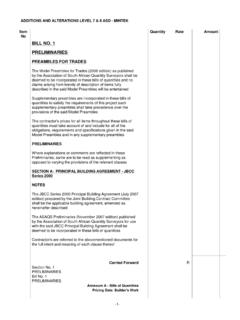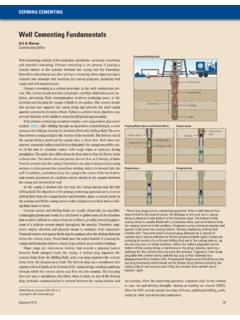Transcription of SOME ASPECTS OF THE PRODUCTION OF …
1 Ferrochromium PRODUCTION some ASPECTS OF THE PRODUCTION OF. FERROCHROME ALLOYS IN PILOT DC ARC FURNACES AT. MINTEK. S. A. C. Hockaday1 and K. Bisaka2. Council for Mineral Technology, 200 Malibongwe Drive, Randburg, South Africa;. ABSTRACT. Ferrochrome alloy is predominantly produced in AC submerged-arc furnaces where the electrodes are buried in the burden of lumpy materials comprised of chromite ores or pellets, reductants and fluxes. Mintek has developed and patented the smelting of chromite ores in DC electric open-arc furnaces; principally for the processing of ore fines of sizes less than 1 mm without the need for agglomeration. Since the inception of this process, the DC arc furnace test facilities at Mintek have been employed to test varying composition, grade and mineralogy of chromite ores using different slag and metal chemistries, resulting in the PRODUCTION of ferrochrome alloys of varying composition and grade.
2 The results of these campaigns primarily demonstrated the robustness and flexibility of the DC arc furnace for the processing of chromite ores and secondly provided a useful database pertaining to the smelting of chromite ores. Using the data collected over a series of DC arc furnace campaigns, the metallurgical control of the alloy composition is discussed. In particular, the reporting of Si and C to the alloy is evaluated based on the smelting conditions and thermodynamic principles. This article attempts to evaluate the results of DC arc smelting of chromite ores, and compare these results with the guidelines proposed in the literature for submerged-arc furnaces. 1 INTRODUCTION. In the conventional PRODUCTION of stainless steels, chromium is generally introduced to the process in the form of Cr-Fe-C-Si alloys, principally as high-carbon ferrochrome or charge chrome.
3 The level of carbon and silicon in the above alloys is important especially when refining is carried out by blowing oxygen in the melt. High-carbon and charge chrome alloys are generally produced in the conventional smelting process by carbothermic reduction of ferrochrome ores using AC submerged-arc and DC open-arc electric furnaces. In AC submerged-arc furnaces, the energy to the furnace is predominantly supplied in a resistive heating mode. The main features of this mode are the electrical resistivity of the slag and the slag liquidus temperature that are strictly selected to operate the process comfortably; these two parameters also impose some limitations to the smelting process in terms of operating temperature. The energy to a DC open-bath furnace is mainly supplied in an arcing mode.
4 This energy is largely independent to the slag chemistry; thus providing more freedom in the selection of the slag composition and process temperature. This freedom has conferred to the DC open-arc furnace a greater ability to control silica reduction more closely by slag chemistry. A reasonably large range of process temperatures can be achieved in DC open-arc as opposed to AC submerged-arc furnace;. subliquidus and superheated slags can be produced in the smelting process. Superheated slag would improve to a certain extent the kinetics of chemical reactions and the slag-metal separation whilst The Twelfth International Ferroalloys Congress Sustainable Future 367 June 6 9, 2010. Helsinki, Finland Ferrochromium PRODUCTION subliquidus slag will have a favorable effect on the furnace lining.
5 Whilst change to the slag chemistry is possible, this is generally restricted by the economics of the process. This paper summarizes some of the ASPECTS of the presence of C and Si reduction in the ferrochrome alloys learnt through the pilot smelting tests of ferrochrome at Mintek. 2 EQUIPMENT AND METHODOLOGY OF TESTWORK AT MINTEK. Equipment Ferrochrome alloys were produced in the and MVA DC open-arc pilot plant facilities at Mintek. A description of the MVA facilities is given here and schematically presented in Figure 1. The power supply to the facilities consisted of an 11 kV vacuum breaker, 2 isolators, 2 contactors, 2 x MVA transformers and 2 x 5 kA thyristor rectifiers able to be configured for single or twin electrode operation. The pilot plant facilities consisted of the batching plant feeding through two final feeders into a furnace with a 2m diameter hearth.
6 The furnace crucible was lined with magnesia based bricks and its hearth consisted of high magnesia namable with steel pins through the hearth serving as anode. The roof was cast in namable alumina. Two tapholes were used to tap metal and slag separately. Lined and cast iron ladles were used for containing metal and slag, respectively. Process control and data logging were managed through the Delta V control system. Batching plant Selector valve Surge bins 1 2. Slide gate valves Main Conveyor Feed bins 1 2. S-c on Final feed bin ve yo r Furnace feed valve Bag filter plant Bag plant fan Stack Electrode hoists and clamps Dilution air valve Fume collection Furnace Furnace slag alloy DC Furnace Figure 1: Schematic of Mintek DC Arc Furnace pilot plant facility Testwork Methodology The test recipes were simulated by Pyrosim, a Mintek developed thermodynamic process simulation package, to obtain the required flux and reductant additions in order to produce liquid slags and metals in the specified operating temperature range.
7 The simulations also provided the process energy required. Excess carbon was allowed in practice to compensate for air ingress into the furnace and reductant inefficiencies. The Twelfth International Ferroalloys Congress Sustainable Future 368 June 6 9, 2010. Helsinki, Finland Ferrochromium PRODUCTION The furnace was slowly warmed up to required temperature prior to undertaking the testwork program. During the electrical warm-up period, the feed was initially introduced into the furnace at lower rates; these rates were progressively increased with subsequent increase of power to the target levels towards the end of this period. After the warm-up period has been completed, slag and metal analyses were used to optimize the smelting recipe. Once stable conditions have been reached and maintained long enough to collect sufficient data, the smelting recipe and/or the power was changed to investigate the subsequent target condition.
8 Throughout the tests, the feed rates of the input materials and the power input to the furnace were balanced to maintain liquid metal and slag at required temperatures without compromising the integrity of the refractory lining of the furnace. 3 PROCESS METALLURGY FOR THE PRODUCTION OF FERROCHROME. The PRODUCTION of ferrochrome metal from chromite ores using a carbonaceous reductant reduces oxides to metal in order of reactivity. The main reactions involved in the reduction of iron, chromium and silicon to the metal phase '+' = atm P(total) isobar are briefly presented below (subscripts x and y 0. -1. indicate that carbides of varying stoichiometry -2. -3. form). -4. -5. -6. log10(P(O2) (atm). -7. The alloy product is likely a mixture of different -8. carbides. -9. -10. SiO2(l). FexCy + Cr2O3 CrO CrxCy -11.)
9 -12. MgO + CrO MgO + CrxCy -13. -14. Cr2O3 CrO CrxCy -15. -16. -17 Si(l). -18. SiC(s2). This is followed by the reduction of silica as -19. -20. follows: -10 -9 -8 -7 -6 -5. log10(P(CO) (atm). -4 -3 -2 -1 0. SiO2 + 2C Si + 2CO or SiO2 + 3C SiC + 2CO. Figure 2: Si predominance diagram for differing The influence of the partial pressure of O2 and O2 and CO partial pressures at 1750 C, CO on the reduction of SiO2 may be seen in FACTSage Figure 2. 4 RESULTS OF TESTS AT MINTEK. Overview of the Testwork Campaigns A number of ferrochrome smelting campaigns were carried out at Mintek. These smelting campaigns produced in total about 229 tonnes of metal alloys and 207 tonnes of slag. The most significant campaigns were carried out in a 2 m diameter furnace operating at a power flux of between 450 and 550 kW/m2.)
10 The furnace was operated in both single and twin electrode (cathode) configurations and both hollow and solid electrodes were used during the tests. Chrome Ores Chromite ores and concentrates smelted at Mintek were characterized by the Cr grade, Cr/Fe ratio and gangue elements as presented in Table 1. The chromite ore Cr/Fe ratio is of importance as it directly affects the alloy Cr grade whilst the gangue elements affect the melting energy and rate as well as the slag chemistry. The chromite spinel ore morphology can be described stoichiometrically as (Fe, Mg)(Cr,Al,Fe)2O4 and chromite ores often contain gangue elements of SiO2 and MgO. Table 1: Composition range of major oxides in chromite ores and concentrates smelted at Mintek DC pilot plant facilities MgO Al2O3 SiO2 CaO Cr2O3 FeO Cr/Fe wt % wt % wt % wt % wt % wt % mass/mass Min Max The Twelfth International Ferroalloys Congress Sustainable Future 369 June 6 9, 2010.







